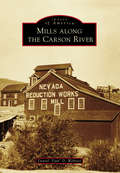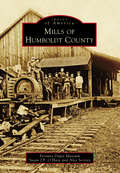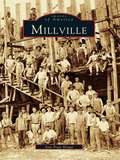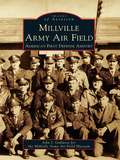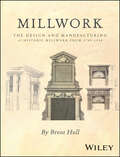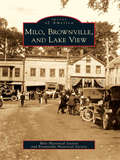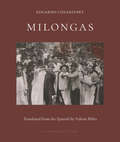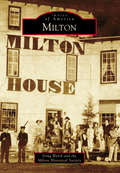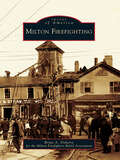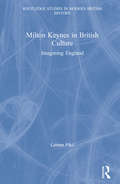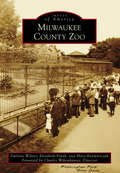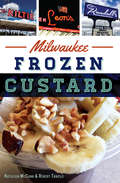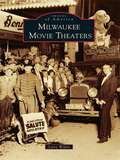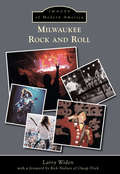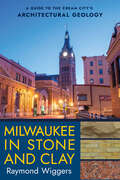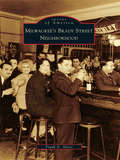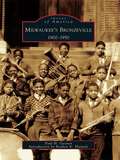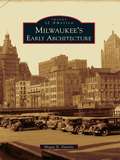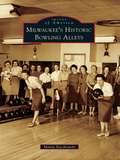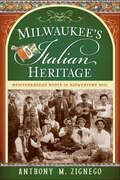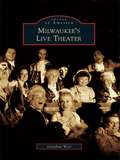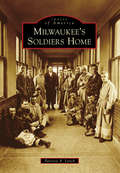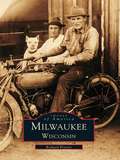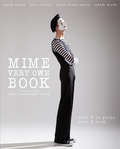- Table View
- List View
Mills Along the Carson River
by Daniel Dan" WebsterNestled along the picturesque Carson River in the state of Nevada were the quartz mills that crushed and extracted the values from the Comstock ore. These mills were built starting in 1859, when gold and silver were discovered on the Comstock, with the last mill being demolished around the 1920s. Mills were huge plants, in many cases crushing tons of ore a day, sometimes seven days a week. To support these mills, the towns of Empire and Dayton were established to house workers and provide needed supplies. Remnants of these mills have all but disappeared, and in a few more years, there will be nothing to remind people of the wealth these establishments created for individuals, the state of Nevada, and the United States.
Mills of Humboldt County (Images of America)
by Fortuna Depot Museum Alex Service Susan J. O’haraHumboldt County was at the forefront of the massive redwood logging industry. The impressive size of the trees necessitated drastic technological advances. Many innovations were invented by Humboldt mill owners like John Dolbeer, whose steam donkey engine mechanized and revolutionized logging all along the West Coast. In 1896, there were 13 mills devoted to sawing redwood lumber and 26 mills making redwood shingles operating in Humboldt County. Other related industries, such as shipbuilding, boiler works, tanbark, and split products, further shaped the economic vitality of the county. Most of these industries no longer exist, and the logging industry is now a shadow of its former self. However, many remnants of the loggers' heyday can still be found. This book explores the sites of Humboldt County's historic lumber industry and the day-to-day realities of life in the mills and the woods.
Millville
by Ann Pratt HouptThe town of Millville, Florida, was born out of the need for lumber to build houses and ships in the late 1800s, when settlers coming to St. Andrews Bay had no way to travel but by sailing vessels. Millville had a sawmill, a shipyard, and several stores. In the winter of 1885-1886, several familiesorganized a Sunday school. They built a small schoolhouse, and the newly formed Watson's Bayou Literary Society met. By 1910, it was the largest community around the bay and the center of commerce and industry for the area. In 1913, leaders incorporated the town, and voters elected W.I. Singletary their first mayor. The future was bright. By 1918, 2,000 residents lived in the town ith hotels, a theater, 31 business establishments, and several churches. Millville was still the largest town on St. Andrews Bay, but just to the west was the growing town of Panama City. In 1926, Millville was annexed into the incorporated limits of Panama City.
Millville Army Air Field: America's First Defense Airport (Images of Aviation)
by John J. Galluzzo Millville Army Air Field MuseumMillville had always been known for its glassmaking, but with the outbreak of World War II, the community's identity was primed to change forever. A private civilian airfield gave way to the creation of America's first defense airport, the training ground for the U.S. Army's Curtiss P-40 Warhawk and Republic P-47 Thunderbolt pilots. Bright and brave young men from across the country converged on Millville in the early 1940s to learn to fly and fight for freedom. Some died in training; others flew into history as heroes. While in Millville, they lived the average lives of the country's military men, playing baseball, flirting with the girls at the local USO dances, and attending Sunday night dinners with local families, creating lifelong friendships in a time when a young man's life expectancy was in the hands of America's enemies.
Millwork: The Design and Manufacturing of Historic Millwork from 1740 - 1950
by Brent HullHistoric millwork expert Brent Hull provides a one-of-a-kind, comprehensive reference of millwork elements found in historic homes from the 18th to 20th centuries. Millwork: The Design and Manufacturing of Historic Millwork from 1740–1950 is organized by type of millwork for ease of reference and includes rare illustrations, hard-to-find drawings, and diagrams from the 19th century, many of which are sourced from out-of-print catalogs in Hull’s private collection. Explore the classification and definition of doors, windows, moldings, mantels, paneled walls, built-ins, and other millwork elements through a historical lens. Learn how architectural millwork elements were designed, manufactured, and constructed during the hand-made (pre-industrial) era and how they changed after World War II. Millwork: The Design and Manufacturing of Historic Millwork from 1740–1950 is a unique and valuable reference for architects, designers, historians, preservationists, builders, or anyone interested in restoring historic homes.
Milo, Brownville, and Lake View (Images of America)
by Brownville Historical Society Milo Historical SocietyIn the wilderness of Piscataquis County, rich in river power and vast with untouched forests, three communities were born. Although each is close in proximity, Milo, Brownville, and Lake View have unique histories and personalities. Milo's beginnings are based on the legend of young Theophilus Sargent, who faced the wild alone, almost perishing but for the kindness of a Native American chief and his son, Attean. One hundred years later, this survival story became the basis for Elizabeth George Speare's book Sign of the Beaver. Along with its grist- and sawmill industries, Brownville's slate quarries were prolific and offered Welsh immigrants a wealth of employment. Lake View Plantation was born because of timber. Merrick Thread Company built a spool mill near Schoodic Lake, whose shores were abundant with birch, and even after the mill closed the community of Lake View remained. Its small permanent population now swells to more than 1,000 in the summer as visitors flock to the beautiful shores of natural spring-fed Schoodic Lake.
Milongas
by Edgardo CozarinskyWith an introduction by award-winning author Alberto Manguel, Milongas is Edgardo Cozarinsky's love letter to tango, and the diverse array of people who give it life.From tango&’s origins in the gritty bars of Buenos Aires, to milongas tucked away in the crypt of a London Church, a café in Kraków, or the quays of the Seine, Cozarinsky guides us through a shape-shifting dance&’s phantasmagoric past. In neighborhood dance halls vibrant and alive through the early hours of the morning, where young and old, foreign and native, novice and master come together to traverse borders, demographics, and social mores, &“it is impossible to distinguish the dance from the dancer.&” As conspiratorial as he is candid, Cozarinsky shares the secrets and culture of this timeless dance with us through glimmering anecdote, to celebrate its traditions, evolution, and the devotees who give it life.
Milton (Images of America)
by Milton Historical Society Doug WelchWhen the traveling party with Joseph Goodrich concluded a months-long journey west from Alfred, New York, in the spring of 1838, the strong-willed abolitionist staked out land some 60 miles west of Milwaukee. The area was then a crossroads of militia trails still worn from the Black Hawk War six years prior. Wisconsin's statehood was 10 years away when Goodrich began platting a community. He began with the Milton House, a unique hexagonal structure made of grout and built to serve as a temperance inn. Later, Goodrich used Milton House to aid fugitive slaves fleeing the South, and the inn became the heart of the community. By 1844, Milton had expanded around the town square. That same year, Goodrich founded Milton Academy, which was chartered as a college in 1867. He also facilitated the arrival of railroad lines, which led to the establishment of Milton's twin village, Milton Junction, the rail hub of southern Wisconsin.
Milton Firefighting (Images of America)
by Brian A. DohertyThe Fireward Society of Dorchester and Milton was founded in 1793 to protect citizens on both sides of the Neponset River. In 1830, both towns recognized Fountain Engine No. 1 as their main source of fire protection in Milton Village and Lower Mills. Later the Hydrant Engine Company was formed in East Milton, reflecting the population growth in this area. When Milton officials recognized that their fire department could not keep up with the growing town, a chemical engine was purchased and installed in a new firehouse built in the center of Milton in 1881. Soon the town acquired a steam engine and installed it in an even larger station. Thus began the gradual development of a professional, full-time fire department in Milton.
Milton Glaser: Graphic Design
by Milton GlaserThis essential volume by the godfather of modern graphic design explores his process and showcases his highly influential early-career work. This gorgeously illustrated volume delves into the early decades of America’s pre-eminent graphic artist. Milton Glaser’s work ranges from the iconic I Love New York logo to the famous psychedelic Bob Dylan poster and numerous book and record covers; it encompasses everything from store and restaurant design to toy creations as well as magazine formats and logotypes, including New York magazine. In short, his work has helped define the look of our time.Here Glaser undertakes a remarkably wide-ranging representation of his oeuvre. In a new introduction, he speaks of the influences on his work, the responsibilities of the artist, the hierarchies of the traditional art world, and the role of graphic design in the area of his creative growth. First published in 1973, Milton Glaser: Graphic Design is an extraordinary achievement and an indisputable classic.
Milton Keynes in British Culture: Imagining England (Routledge Studies in Modern British History)
by Lauren PikóThe new town of Milton Keynes was designated in 1967 with a bold, flexible social vision to impose "no fixed conception of how people ought to live." Despite this progressive social vision, and its low density, flexible, green urban design, the town has been consistently represented in British media, political rhetoric and popular culture negatively. as a fundamentally sterile, paternalistic, concrete imposition on the landscape, as a "joke", and even as "Los Angeles in Buckinghamshire". How did these meanings develop at such odds from residents' and planners' experiences? Why have these meanings proved so resilient? Milton Keynes in British Culture traces the representations of Milton Keynes in British national media, political rhetoric and popular culture in detail from 1967 to 1992, demonstrating how the town's founding principles came to be understood as symbolic of the worst excesses of a postwar state planning system which was falling from favour. Combining approaches from urban planning history, cultural history and cultural studies, political economy and heritage studies, the book maps the ways in which Milton Keynes' newness formed an existential challenge to ideals of English landscapes as receptacles of tradition and closed, fixed national identities. Far from being a marginal, "foreign" and atypical town, the book demonstrates how the changing political fortunes of state urban planned spaces were a key site of conflict around ideas of how the British state should function, how its landscapes should look, and who they should be for.
Milwaukee County Zoo
by Elizabeth Frank Darlene Winter Mary KazmierczakFrom the inception of the Milwaukee County Zoo at West Park in 1892, the citizens of Milwaukee have worked diligently to make it one of the finest zoos in the country. Their tireless effort and faith were rewarded. The zoo experienced many firsts, including the first polar bear born in captivity in North America, and was home to Samson, one of the largest gorillas in captivity. Throughout its history, the zoo also gained fame for innovative exhibit design. The zoo has flourished through the cooperation of Milwaukee County and the Zoological Society of Milwaukee. This public-private relationship has existed successfully since 1910.
Milwaukee Frozen Custard (American Palate)
by Robert Tanzilo Kathleen MccannFrozen custard is more than a dessert in Milwaukee. It's a culture, a lifestyle and a passion. From the stand that inspired television's Happy Days to the big three--Gilles, Leon's and Kopp's--take a tour through the history of this guilty pleasure. Learn about its humble origins as an unexpected rival to ice cream and its phenomenal success as a concession at the Chicago World's Fair in 1933 that made the snack famous. Find the stories behind your favorite flavor at local festivals and homegrown neighborhood stands. Milwaukee authors and editors Kathleen McCann and Robert Tanzilo launch a celebration of custard lore, featuring a stand guide and much more. Dig into what makes Milwaukee the Frozen Custard Capital of the World.
Milwaukee Movie Theaters: A Pictorial History Of Milwaukee's Movie Theaters (Images of America)
by Larry WidenPrior to World War II, there were 90 single-screen movie theaters in Milwaukee. By 1960, that number had been reduced by half. With the arrival of television for the home market, the golden age of the movie theater in Milwaukee was dead. Yet their ghosts continue to haunt the old neighborhoods. Churches, warehouses, stores, nightspots, and other businesses now occupy the former Tivoli, Paris, Roosevelt, and Savoy Buildings. Others are simply vacant hulks, decaying from the inside out. The Elite, Regent, Lincoln, and Warner are but a few of the many silent sentinels from the days when Milwaukee was in love with the movies.
Milwaukee Rock and Roll
by Larry Widen Rick Nielsen of Cheap TrickThe history of rock music in Milwaukee began at an age when some musicians played in a segregated part of the city. At the same time, a young singer named Buddy Holly kicked off a tour that ended with a plane crash in Iowa 11 days later. The following years brought the Beatles, Rolling Stones, and the rest of the British Invasion. In the late 1960s came acid rock, civil unrest, and Summerfest, a music festival that continues to this day. Milwaukee has had its moments in the spotlight: Bob Dylan left the stage after two songs in 1964, Bruce Springsteen's 1975 concert was delayed for hours while police searched for a bomb in the theater, hundreds of Black Sabbath fans rioted after a 1980 show, and the Plasmatics' Wendy O. Williams was beaten by police in 1981. And then there was the helicopter crash in which blues guitarist Stevie Ray Vaughn perished.
Milwaukee in Stone and Clay: A Guide to the Cream City's Architectural Geology
by Raymond WiggersMilwaukee in Stone and Clay follows directly in the footsteps of Raymond Wiggers's previous award-winning book, Chicago in Stone and Clay. It offers a wide-ranging look at the fascinating geology found in the building materials of Milwaukee County's architectural landmarks. And it reveals the intriguing and often surprising links between science, art, and engineering. Laid out in two main sections, the book first introduces the reader to the fundamentals of Milwaukee's geology and its amazing prehuman history, then provides a site-by-site tour guide. Written in an engaging, informal style, this work presents the first in-depth exploration of the interplay among the region's most architecturally significant sites, the materials they're made of, and the sediments and bedrock they're anchored in. Raymond Wiggers crafted Milwaukee in Stone and Clay as an informative and exciting overview of this city. His two decades of experience leading architectural-geology tours have demonstrated the popularity of this approach and the subject matter.
Milwaukee's Brady Street Neighborhood
by Frank D. AliotoMilwaukee's Brady Street neighborhood, bounded by the Milwaukee River, Lake Michigan, Ogdon Avenue, and Kane Place, is arguably the most densely-populated square mile in the state of Wisconsin. A mix of historic shops, single-family homes, apartments, and condos, Brady Street boasts of great diversity that draws from many distinct eras. It began in the mid-19th century as a crossroads between middle-class Yankees from the east and early German settlers. Polish and Italian immigrants soon followed, working the mills, tanneries, and breweries that lined the riverbank. After these groups had assimilated and many of their descendents moved to the suburbs, the hippies in the 1960s arrived with their counterculture to fill the void. By the 1980s, the area fell into blight, neglect, and decay; now, a true model for new urbanism, the Brady Street neighborhood is in the midst of a renaissance.
Milwaukee's Bronzeville: 1900-1950 (Images of America)
by Paul H. Geenen Reuben K. HarpoleWith the migration of African American sharecroppers to northern cities in the first half of the 20th century, the African American population of Milwaukee grew from fewer than 1,000 in 1900 to nearly 22,000 by 1950. Most settled around a 12-block area along Walnut Street that came to be known as Milwaukee's Bronzeville, a thriving residential, business, and entertainment community. Barbershops, restaurants, drugstores, and funeral homes were started with a little money saved from overtime pay at factory jobs or extra domestic work taken on by the women. Exotic nightclubs, taverns, and restaurants attracted a racially mixed clientele, and daytime social clubs sponsored "matinees" that were dress-up events featuring local bands catering to neighborhood residents. Bronzeville is remembered by African American elders as a good place to grow up--times were hard, but the community was tight.
Milwaukee's Early Architecture
by Megan E. DanielsInitially dominated by simple renditions of East Coast architecture, Milwaukee developed from three pioneer settlements, those of Solomon Juneau, Byron Kilbourn, and George Walker--three hubs from which three villages radiated outward into one city. Following the Civil War, Milwaukee's growth at the onset of the Industrial Era afforded the city a fanciful array of Victorian streetscapes. The 1890s followed with an era of ethnic architecture in which bold interpretations of German Renaissance Revival and Baroque designs paid homage to Milwaukee's overwhelming German population. At the turn of the century, Milwaukee's proximity to Chicago influenced the streetscape with classicized civic structures and skyscrapers designed by Chicago architects. World War I and the ensuing anti-German sentiment, as well as Prohibition, inevitably had adverse effects on "Brew City." By the 1920s, Milwaukee's architecture had assimilated to the national aesthetic, suburban development was on the rise, and architectural growth would soon be stunted by the Great Depression.
Milwaukee's Historic Bowling Alleys (Images of America)
by Manya KaczkowskiFrom the U.S. Olympic team, to "Bowling with the Champs," to countless corner bars with a couple of lanes in the basement, Milwaukee has lived and breathed this sport. In the late 1800s, German brewers like Capt. Frederick Pabst and the Uihleins offered bowling in their Milwaukee beer gardens. When Abe Langtry brought the American Bowling Congress here in 1905, "Brew City" became bowling central. Today owning a bowling alley is a labor of love, with good reason. It's the place where you rolled that 700 series, met your wife, and taught your son how to bowl in the junior league. Even in this high-tech, immediate-gratification society, bowling still thrives in Milwaukee. Several old-school lanes still have steady business, and this book is a tribute to the people, the places, and the sport that made Milwaukee "America's Bowling Capital."
Milwaukee's Italian Heritage: Mediterranean Roots in Midwestern Soil (American Heritage)
by Anthony M. ZignegoThe shores of Lake Michigan might seem a far cry from the coastline of the Mediterranean, even for a country famous for its opera singers. Nevertheless, enough Italians responded to the call�and returned home to repeat it confidently to brothers, brides and strangers�to create a thriving community in Milwaukee. Historians often emphasize Milwaukee�s German heritage, content to relegate the story of Italian migration to New York or Chicago, but Anthony Zignego passionately explores the ways in which Italians shaped the Brew City and were shaped by it in turn. From the Gardetto family to the enterprising women of the Third Ward to Festa Italiana, Zignego presents a portrait of the immigrant experience with personal stories and interviews with �ordinary� immigrants and Milwaukeeans, explaining the community�s traditions and dispelling some of its myths. Milwaukee�s Italian Heritage highlights the struggles and triumphs that have always made immigration an opening clause and concluding question in the American story.
Milwaukee's Live Theater (Images of America)
by Jonathan WestMilwaukee's live theater scene is the sum of several exciting parts. For many, Milwaukee live theater means world-class productions done by resident actors at one of the nation's leading regional theaters. For others, it has been defined by the machinations of a respected experimental theater troupe that traveled throughout Europe in the 1980s and was once honored with an Obie Award. There was a time when Milwaukee live theater meant a big top arena where some of the biggest stars of American musical theater frolicked and played for local audiences. Audiences in Milwaukee have enjoyed the classics, new plays, and contemporary hits performed by never-say-die producers who boast personalities larger than the stages their companies play upon. The Milwaukee theater style is not fussy or overblown. It is informed by a thrilling past, buoyant future, unsurpassed community support, and unfailing devotion to solid midwestern work ethics channeled into artistic innovation. Simply put, Milwaukee's live theater scene is the best-kept artistic secret in the United States.
Milwaukee's Soldiers Home (Images of America)
by Patricia A. LynchAs the country sought healing and peace after the Civil War, Wisconsin citizens took up Pres. Abraham Lincoln's challenge "to care for him who shall have borne the battle." Their efforts paved the way for the establishment in Milwaukee of one of the original three branches of the National Asylum for Disabled Volunteer Soldiers. In May 1867, the first 60 veterans, including a musician from the War of 1812, moved to a single building on 400 rolling acres west of Milwaukee. By the end of the 19th century, the bustling campus boasted its own hospital, chapel, library, theater, and recreation hall, in addition to the grand main building. Subsequent wars and military conflicts created a need for additional buildings and services. Designated a National Historic Landmark in 2011, the campus continues to offer a healing environment for today's patients and stands as a testimony to advances in veteran health care.
Milwaukee, Wisconsin
by Richard PrestorIn April 1834, the Green-Bay Intelligencer newspaper reported that a sawmill was being erected in a new settlement on the Milwaukee River. Less than one year later, the paper reported that "Milwaukey [sic], which 10 months ago, had only a single trading house, has now some 20 or 30 houses, and two or three saw mills." Yankee settlers and land speculators had moved in and were here to stay. The steady growth of Milwaukee was never wholly due to the influx of ambitious Easterners though. In ever-expanding numbers, Europeans also made their way here, not merely as settlers, but frequently as hard-working business owners, skilled laborers, and artists. They were determined to make Milwaukee their home, and in this new homeland they surrounded themselves (and influenced the entire community) with their old traditions and languages. Thirty years after its first newspaper write-up, Milwaukee was a well-established city brimming with potential.
Mime Very Own Book
by Josh Poncemime" Perry Scott Allen Perry Eric Curtis Adam Mock Doug JonesA hilarious visual smorgasbord, this vibrant photo narrative offers a quiet, introspective look into life as a silent emoter. Replete with images of actor and mime artist Doug Jones shot against an array of artistic and real-world backdrops, this social commentary spoofs pop culture and fairy tale favorites. Witty photo parodies include Frank 'n mime, Marilyn Mime-roe, Mime-hammad Ali, Mime a Llama ding-dong, and Mimeageddon, as well as the "Once Upon a Mime" tales in which the big bad wolf gets bested in a series of mime encounters based on Little Red Miming Hood and the Three Little Pigs-poking fun at legendary personalities, characters, and moments while showcasing photographer Eric Curtis's trademark vision.
